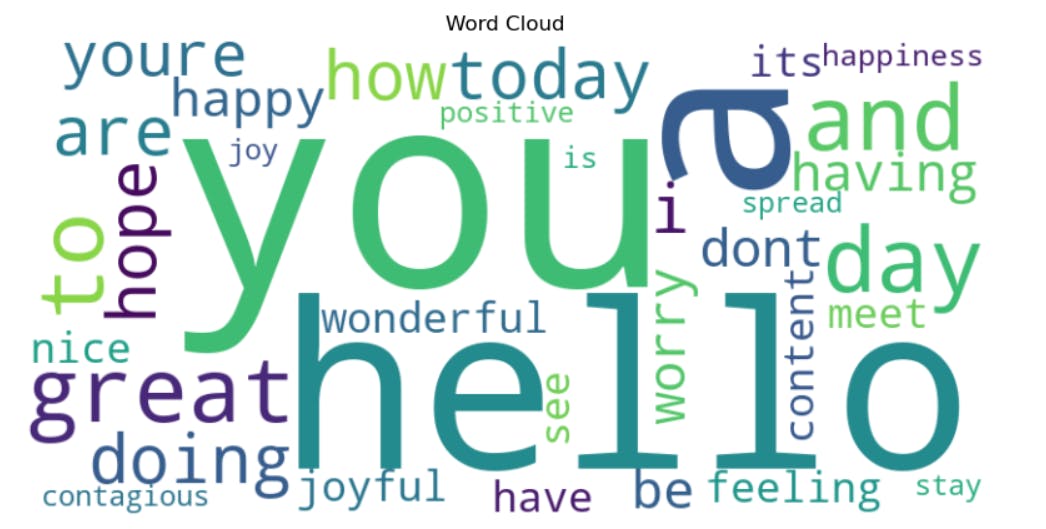Harnessing the Magic of Word Clouds: Unveiling Textual Insights in a Glance
Words have the intriguing capacity to weave narratives, stir passions, and reveal hidden truths in the enigmatic universe of language. A magnificent invention called word clouds has emerged in this mesmerising environment of words, changing the art of data visualisation. Extraction of meaningful insights from huge troves of text necessitates new and visually appealing methodologies. The word cloud is one such strong tool that has changed the landscape of data visualisation. In this article, we will take an exciting voyage into the alchemy of word clouds, investigating their importance and applications in textual data analysis. Along with this exploration, we'll go into practical implementation, creating a compelling word cloud to uncover the essence of a sample dataset.
Word Clouds' Enchanting Symphony
Consider the skill involved in making a simple text into a word symphony. Word clouds, also known as tag clouds or text clouds, are visual representations that transform raw textual data into visually appealing art. Each word appears like a note in a symphony, arranged according to its frequency of occurrence. As a result, the most prominent words glow like stars in the night sky, creating a mesmerising spectacle.
Behind the Sorcery Is Science
To create a word cloud, we must first learn how to manipulate data. We begin with a collection of texts and integrate them into a single string, creating a text tapestry. This masterwork is transformed, losing punctuation and wearing lowercase clothing. After that, the tapestry is divided into individual words, revealing the hidden gems of speech. As the words become more visible, their frequencies are counted utilising the enigmatic power of the Counter from the collections library.
Finding the Lost Treasures
We discover patterns in the word cloud as we examine it, patterns that reveal the text's core like mystical sigils. A visual spectacle reveals prevailing themes, recurrent concepts, and prevailing feelings. In order to help us identify the underlying storylines, the word cloud transforms into an enthralling portal for comprehending the collective voice within the data.
The Communication Alchemy of Word Clouds
Word clouds work as the philosopher's stone in the fields of communication and marketing, converting unprocessed textual information into useful insights. Businesses can interpret consumer mood, hone strategy, and develop gripping storylines. Word clouds have the power to reveal the Search Engine Optimisation (SEO) alchemy's secrets and reveal the keywords that will lead to online fame.
Word clouds in education and research
Sorcery of Knowledge Word clouds give student replies life in the enchanted world of education, highlighting areas of excellence and suggesting areas for development. Teachers and educators get profound awareness of their pupils' overall understanding. Word clouds shed light on the essence of huge information amid the maze of inquiry, directing researchers to the crux of their questions.
The Art of Textual Insights
Data Visualisation Using Word Clouds A wonderful conjuring happens when word clouds combine with other visualisation approaches. When word clouds are combined with bar charts and graphs, data visualisation takes on a multidimensional feel. Through this ethereal union, insights transcend the confines of conventional presentations and captivate listeners with word clouds' unmatched storytelling abilities.
Practical Application: Producing an Entertaining Word Cloud
Let's set off on a useful trip to create a fascinating Python word cloud. To get started, we define a sample DataFrame with messages. We use the mystical technique of data manipulation and visualisation with Python's magical modules, including wordcloud, collections, and matplotlib. Watch how the word cloud appears, encapsulating the provided messages' essence in a breathtaking visual portrayal.
import pandas as pd
import re
from wordcloud import WordCloud
from collections import Counter
import matplotlib.pyplot as plt
# Sample DataFrame containing messages
data = {
'message': [
"Hello, how are you doing today?",
"I hope you're having a great day!",
"Don't worry, be happy!",
"Feeling joyful and content.",
"Have a wonderful day!",
"Hello, it's nice to meet you.",
"Great to see you!",
"Happiness is contagious.",
"Stay positive and spread joy!"
]
}
# Create a DataFrame from the sample data
df = pd.DataFrame(data)
# Combine all the messages into a single string
all_messages = ' '.join(df['message'])
# Remove punctuation and convert to lowercase
all_messages = re.sub(r'[^\w\s]', '', all_messages).lower()
# Split the string into individual words
words = all_messages.split()
# Count the frequency of each word
word_counts = Counter(words)
# Generate the word cloud
wordcloud = WordCloud(width=800, height=400, background_color='white').generate_from_frequencies(word_counts)
# Display the word cloud using matplotlib
plt.figure(figsize=(10, 5))
plt.imshow(wordcloud, interpolation='bilinear')
plt.axis('off')
plt.title('Word Cloud')
plt.show()

To create a word cloud in this example, we'll utilise a sample DataFrame with messages and follow the same steps as before. The word frequencies in the provided messages are then represented aesthetically and visually appealingly by the word cloud created using matplotlib.
If you want to use this code on your own dataset, keep in mind to change the sample DataFrame with your actual data. In order to correctly run the code, make sure you have installed the necessary libraries (pandas, wordcloud, and matplotlib).
Conclusion
Word clouds have a magical attraction that goes beyond traditional data visualisation techniques. We discover buried truths buried within the wide world of language when we accept their magic. The harmony of words serves as a portal to comprehension, enabling us to quickly comprehend and communicate the substance of textual information. The alchemy of textual insights continues to be profoundly influenced by word clouds, whether in communication, teaching, research, or data visualisation. Accept the allure of word clouds and set out on a remarkable adventure into the world of language visualisation.